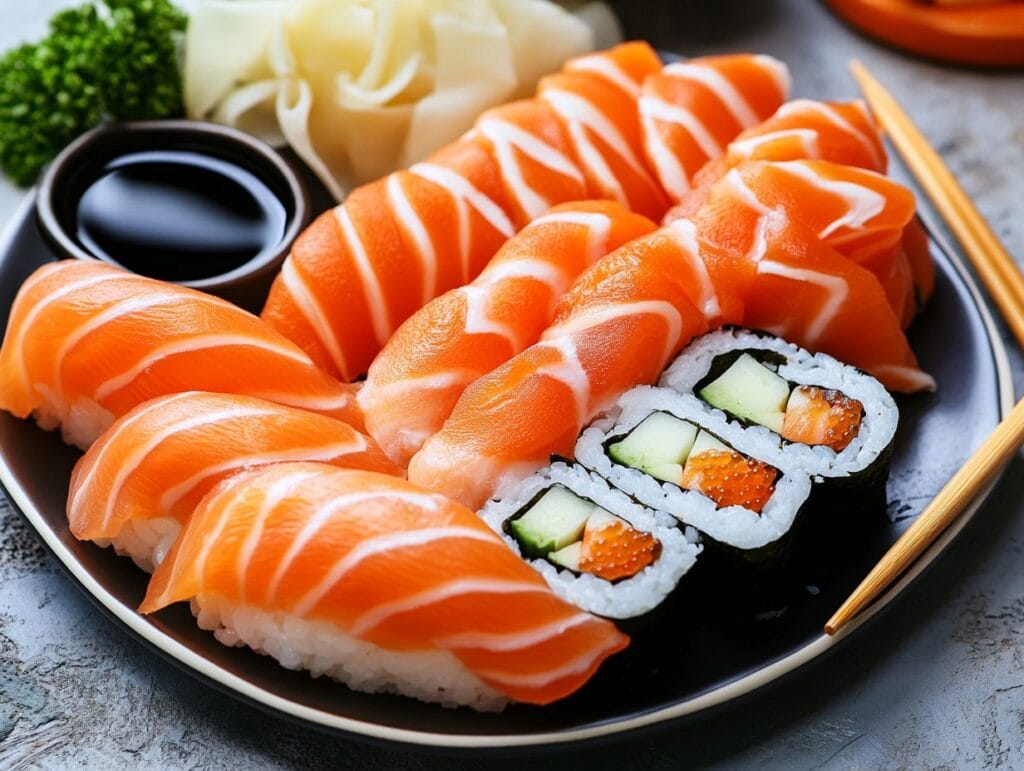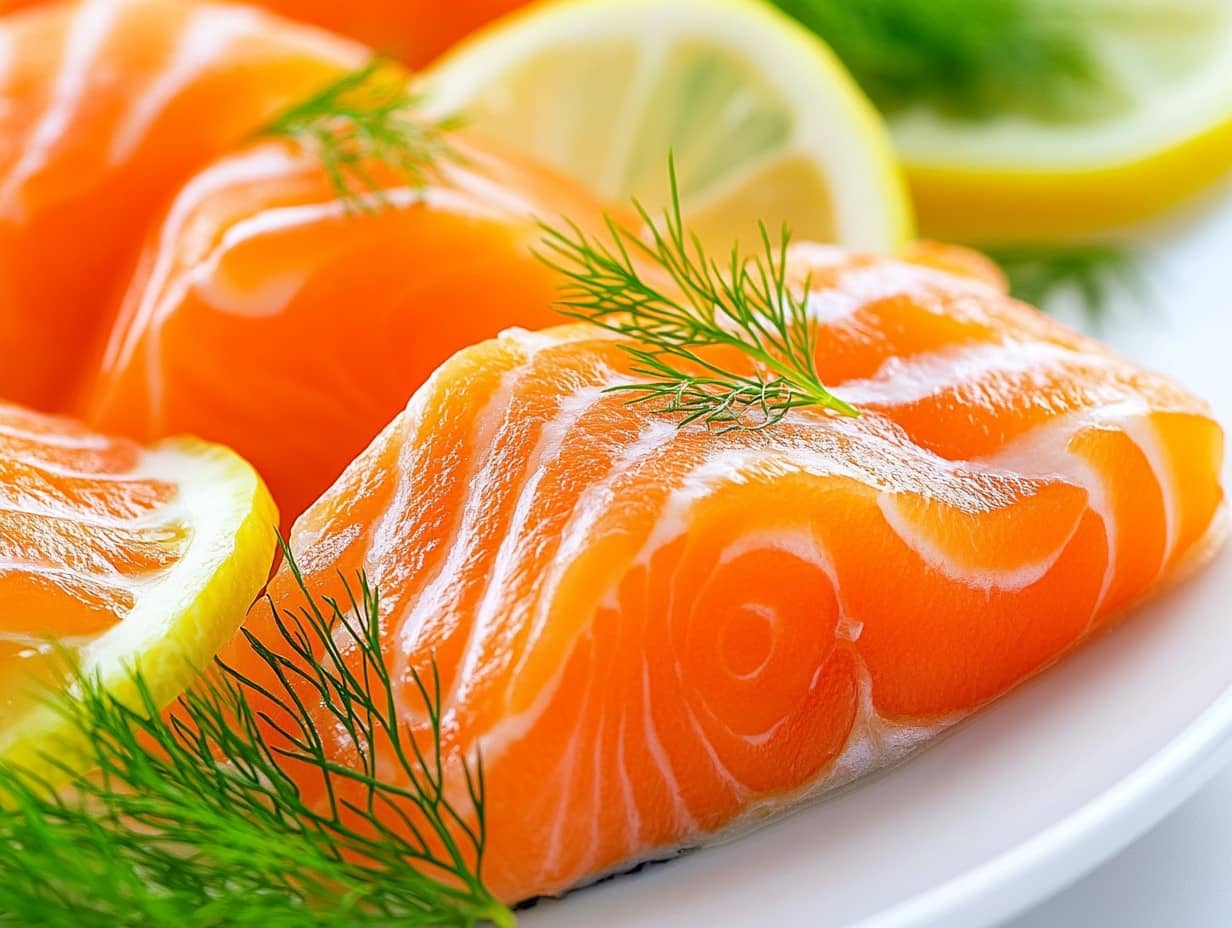Introduction
Salmon is a versatile fish loved by people worldwide. Whether you’re a fan of sushi, sashimi, or lightly seared salmon, the question often pops up: Can you eat salmon a bit raw? Some like the delicate, buttery texture of raw salmon, but is it safe? What are the risks and rewards of indulging in this culinary delight? Buckle up as we dive deep into everything you need to know about eating salmon a bit raw. 🐟
Understanding Raw Salmon Consumption
What Does “A Bit Raw” Mean?
When people say they like their salmon “a bit raw,” they usually mean partially cooked, like a seared salmon fillet with a still-raw center. It can also refer to raw salmon used in dishes like sushi or tartare. The idea is to enjoy salmon in its most natural, tender state without fully cooking it. Think of it as halfway between sashimi and a grilled fillet.
Eating salmon this way enhances its silky texture and highlights its fresh, oceanic flavor. But it’s not just about taste it’s a balancing act between bold culinary adventures and staying safe.
Why Is Raw Salmon Popular in Many Cuisines?
Raw salmon isn’t just trendy; it’s been a part of global cuisines for centuries. From Japanese sashimi to Scandinavian gravlax, cultures worldwide embrace this fish for its freshness and adaptability.
Here’s why:
- Flavor explosion: Raw salmon delivers a subtle, natural taste that’s hard to beat.
- Textural appeal: It’s soft and melts in your mouth like butter.
- Health perks: People believe raw salmon keeps nutrients intact compared to cooking.
“Raw fish has a flavor that speaks for itself, needing only minimal seasoning to shine,” says Chef Haruto Matsumoto, a sushi expert from Tokyo.
Is It Safe to Eat Salmon a Bit Raw?
Factors Affecting Safety: Freshness and Source
Not all salmon is created equal, and safety depends on how it’s sourced and handled. Wild-caught salmon has a different safety profile than farmed salmon, and where you buy it matters. Always go for sushi-grade salmon, which is specifically handled to minimize risks.
- Freshness is key: Check for firm flesh, a shiny surface, and a mild smell.
- Freezing matters: Proper freezing can kill harmful parasites lurking in raw salmon.
Fun fact: The FDA recommends freezing salmon at -4°F (-20°C) for at least seven days to eliminate parasites.If you’re exploring new ways to cook salmon, check out how to prepare salmon bites for inspiration.
Health Risks of Eating Salmon Raw or Undercooked
Eating salmon raw or undercooked comes with risks, like parasites and bacterial contamination. Some of the common culprits include:
- Anisakis worms: These nasty parasites can cause stomach pain, nausea, and vomiting.
- Listeria: A bacteria that can lead to food poisoning, especially dangerous for pregnant women.
- Salmonella: Found in improperly handled seafood.
But don’t worry buying high-quality salmon and following safety steps can greatly reduce these risks.
Who Should Avoid Eating Raw Salmon?
Not everyone should dive into raw salmon. If your immune system is weak or you’re pregnant, avoid it altogether. Children, older adults, and people with chronic illnesses are also more vulnerable to foodborne illnesses.
Benefits of Eating Salmon a Bit Raw
Nutritional Value of Raw Salmon
Raw salmon is a powerhouse of nutrition. It’s packed with protein, healthy fats, and essential vitamins. Compared to cooked salmon, raw versions retain more of their water-soluble nutrients like vitamin C and some B vitamins.For a flavor pairing guide, explore what sauce goes with salmon to elevate your dish.
Here’s a breakdown of what you get in just 3 ounces of raw salmon:
| Nutrient | Amount |
|---|---|
| Omega-3 Fatty Acids | 1.5–2.5 grams |
| Protein | 17 grams |
| Vitamin D | 10 mcg |
“Raw salmon offers an unmatched nutritional punch, making it a favorite for health enthusiasts,” says nutritionist Emily Carter.
The Role of Omega-3 Fatty Acids in Raw Salmon
Omega-3s are the MVPs of raw salmon. These fatty acids improve brain health, reduce inflammation, and support heart health. Think of omega-3s as the oil that keeps your body’s engine running smoothly.
Eating raw salmon also gives your skin that healthy glow, thanks to its high antioxidant content.
Enhanced Flavors and Culinary Experiences
Eating salmon a bit raw opens up a world of culinary possibilities. From poke bowls to ceviche, raw salmon can be transformed into vibrant dishes bursting with flavor. Its mild taste pairs perfectly with everything from citrusy marinades to spicy sauces.
Block Quote:
“Raw salmon is like a blank canvas you can paint it with flavors from around the globe,” says Chef Elena Rivera.
Common Concerns About Raw Salmon
Parasites in Salmon: What You Need to Know
Parasites are a major concern for raw salmon lovers. Wild-caught salmon is more prone to parasites, while farmed salmon has a lower risk. Freezing is your best defense against these tiny invaders.
Quick Tip: Always ask your fishmonger if the salmon is sushi-grade or has been frozen properly before eating it raw.
Contaminants and Pollutants in Salmon
Salmon, especially wild varieties, can contain pollutants like mercury or PCBs (polychlorinated biphenyls). Although levels are typically low, it’s still wise to limit raw salmon consumption to a few times a week.
Differences Between Wild-Caught and Farmed Salmon
- Wild-caught salmon: More flavorful but higher in parasite risk.
- Farmed salmon: Lower risk of parasites but may contain antibiotics or contaminants.
Choose what fits your preference, but ensure it’s from a trusted source.
How to Safely Eat Salmon a Bit Raw
Choosing the Right Type of Salmon
Sushi-grade salmon is your safest bet. This label ensures the fish has been frozen to kill parasites and handled with care.
Checklist for Picking the Best Salmon:
- Firm, moist flesh.
- No fishy or off-putting smell.
- Vibrant color, free of gray patches.
Proper Storage and Handling of Salmon
Handle your salmon like you would a delicate treasure. Keep it refrigerated at 32°F (0°C) and consume it within 1-2 days of purchase. Always wash your hands and utensils to avoid cross-contamination.
Inspecting Salmon for Freshness and Quality
Before eating, check for these signs of freshness:
- Bright eyes: If buying whole fish, clear eyes mean freshness.
- No slime: The flesh should be slightly firm, not slimy.
- Mild smell: A strong odor is a red flag.
Best Ways to Prepare Salmon for Partial Raw Consumption
Traditional Dishes Featuring Raw or Partially Raw Salmon

Raw or partially raw salmon has inspired countless traditional dishes around the globe. These recipes highlight salmon’s delicate flavor while ensuring it’s safe to eat. Here are a few popular ones:
- Sushi and Sashimi: Originating in Japan, these dishes often use thin slices of raw salmon served with soy sauce, wasabi, and pickled ginger.
- Poke Bowls: A Hawaiian favorite, poke bowls combine raw salmon chunks with soy sauce, sesame oil, and toppings like avocado, seaweed, and scallions.
- Gravlax: A Nordic delicacy, gravlax involves curing raw salmon with salt, sugar, and dill. The curing process enhances the flavor and ensures some degree of preservation.
- Ceviche: While traditionally made with white fish, ceviche can include raw salmon marinated in citrus juice. The acid “cooks” the fish and eliminates bacteria.
Each dish showcases the versatility of salmon, and with the right preparation, it can be a flavorful and safe experience.For a deeper dive into cooking techniques, you can learn how to cook Sam’s Club salmon bites for a perfect sear.
How to Sear Salmon While Keeping It Partially Raw
If you’re aiming for a dish with a lightly cooked exterior and a raw center, a quick sear is the way to go. Here’s how to nail it:
- Start with sushi-grade salmon. This ensures the raw portion is safe to eat.
- Preheat a skillet to high heat. Use a non-stick pan or a well-oiled cast iron skillet.
- Season lightly. Add salt, pepper, and optional spices like smoked paprika.
- Sear for 1-2 minutes per side. The goal is to form a golden crust while keeping the center raw.
This technique is perfect for dishes like tataki, a Japanese method where the fish is flash-seared and then sliced thin.
Pro Tip: Let the seared salmon rest for a minute before slicing to lock in its juices.
Marinating Techniques for Enhanced Safety and Flavor
Marinating salmon can add flavor and improve safety by reducing bacteria. Acidic ingredients like lemon juice, vinegar, or soy sauce play a dual role: they enhance taste while slightly “cooking” the salmon.
Simple Marinade Recipe for Raw Salmon:
- 3 tablespoons soy sauce
- 1 tablespoon rice vinegar
- 1 teaspoon sesame oil
- 1 teaspoon grated ginger
- Juice of 1 lime
Combine the ingredients, pour over the salmon, and let it marinate for 10-15 minutes. Avoid over-marinating, as it can break down the fish’s delicate texture.
Comparing Raw Salmon to Fully Cooked Salmon
Taste and Texture Differences
The primary difference between raw and cooked salmon is texture. Raw salmon is silky, buttery, and melts in your mouth. Cooked salmon, on the other hand, is firmer and flakier, with a more robust flavor.
Raw salmon also has a cleaner, fresher taste that pairs well with mild or tangy sauces. Meanwhile, cooked salmon tends to hold up better in rich, hearty dishes.
Block Quote:
“Eating raw salmon is like savoring the essence of the ocean, while cooked salmon feels like a warm hug on a rainy day.”
Cooking and Nutrient Retention
While raw salmon preserves more vitamins like B6 and B12, cooking can enhance the bioavailability of certain nutrients, like protein and omega-3s. Cooking also kills bacteria and parasites, making it a safer choice for some.
That said, if safety measures are followed, eating raw salmon occasionally can provide a nutritional edge without compromising health.
Dietary Preferences and Cultural Influences
Cultural and dietary preferences often dictate whether people prefer raw or cooked salmon. In Japan, raw salmon is a staple of everyday meals, while Western cuisines tend to favor fully cooked preparations.
This diversity in preparation styles shows how salmon adapts to various tastes and traditions, making it a true culinary chameleon.
Can Pregnant Women Eat Salmon a Bit Raw?
Risks for Pregnant Women and Unborn Babies
Pregnant women should approach raw or partially raw salmon with caution. The risk of foodborne illnesses like listeriosis and toxoplasmosis increases during pregnancy, potentially harming the baby.
Listeria, a bacteria often found in raw or undercooked seafood, can cause severe complications like premature delivery or miscarriage. Even sushi-grade salmon isn’t entirely risk-free for expectant mothers.For creative alternatives, discover what mixes well with salmon.
Alternatives to Raw Salmon for Pregnant Women
If you’re pregnant but craving salmon, opt for cooked options. Grilled, baked, or poached salmon can satisfy your taste buds while ensuring safety.
For dishes traditionally served with raw salmon, consider creative substitutions:
- Smoked salmon: Adds similar flavor without the risks.
- Cured salmon (with caution): Only if it’s been fully pasteurized.
Pregnancy doesn’t mean missing out on salmon it’s all about making safer choices.
Expert Recommendations for Raw Salmon Consumption
Insights from Nutritionists and Chefs
Experts agree that eating salmon a bit raw is safe when precautions are followed. Nutritionist Dr. Helen Moore advises:
“Always opt for sushi-grade salmon from a trusted supplier, and store it at proper temperatures to minimize risks.”
Chefs emphasize the importance of quality. “Freshness is everything when it comes to raw salmon,” says Chef Alex Martinez. “You don’t need fancy seasoning let the fish speak for itself.”
Tips for Safely Incorporating Raw Salmon in Your Diet
If you’re ready to dive into raw salmon, follow these expert tips:
- Buy from reputable sources. Ask if it’s sushi-grade or has been flash-frozen.
- Stick to small portions. Moderation reduces exposure to potential contaminants.
- Experiment with recipes. Start with marinated or seared options before going fully raw.
Addressing Myths About Eating Salmon a Bit Raw
Myth: All Raw Salmon is Unsafe
Let’s bust this myth first. Not all raw salmon is unsafe. Sushi-grade salmon, for example, is carefully handled and frozen to kill harmful parasites, making it safe for raw consumption. The key lies in how the salmon is sourced, processed, and prepared.
While risks exist, they’re manageable with proper precautions. Just because raw salmon carries potential dangers doesn’t mean you have to avoid it altogether. Instead, think of it as enjoying an adventure—just bring a safety net!
Myth: Raw Salmon Has No Health Benefits
Some people believe that cooking salmon enhances its nutritional value, but this isn’t entirely true. Raw salmon retains certain heat-sensitive nutrients, like vitamin C and enzymes, which are often lost during cooking.
What’s more, eating raw salmon delivers omega-3 fatty acids in their most natural state. These fats keep your heart healthy, support brain function, and may even boost your mood.
“Raw salmon isn’t just delicious; it’s a powerhouse of nutrients,” says Dr. Rachel Stone, a leading dietitian.
Myth: Frozen Salmon is Unsuitable for Raw Consumption
Freezing salmon doesn’t ruin its quality for raw consumption in fact, it’s essential. Flash-freezing kills parasites without altering the taste or texture of the fish. Many sushi-grade salmon products are frozen immediately after being caught to lock in freshness.
So, the next time someone scoffs at frozen fish, remind them that it’s not only safe but often the industry standard for raw preparation.
Frequently Asked Questions
How do you prepare salmon to eat it a bit raw?
Start by buying sushi-grade salmon from a trusted source. Store it properly at cold temperatures, and use clean utensils to avoid cross-contamination. If you’re making a dish like sashimi, slice the salmon thinly against the grain. For dishes like poke or ceviche, cut it into small cubes and marinate briefly.
Can freezing salmon eliminate parasites?
Yes! Freezing salmon at -4°F (-20°C) for at least seven days kills most parasites. However, freezing doesn’t eliminate bacteria, so always ensure the fish is fresh and stored properly.
What dishes include partially raw salmon?
Some popular dishes featuring partially raw salmon include sushi, sashimi, poke bowls, gravlax, and salmon tartare. These dishes highlight the fish’s silky texture and natural flavors.
How can I tell if salmon is fresh enough to eat raw?
Fresh salmon should smell mild and oceanic, not fishy. The flesh should be firm to the touch, shiny, and free of discoloration. If buying whole fish, check the eyes they should be clear, not cloudy.
Is sushi-grade salmon different from regular salmon?
Yes, sushi-grade salmon is specially prepared for raw consumption. It’s flash-frozen to kill parasites and handled under strict sanitary conditions, making it safer to eat raw than regular salmon.
Can you eat salmon raw if it’s not sushi-grade?
It’s not recommended. Non-sushi-grade salmon may not have undergone the necessary freezing processes to kill parasites. Stick to sushi-grade options for raw or partially raw dishes.
Conclusion: Is Eating Salmon a Bit Raw Worth It?
If you’re a fan of adventurous eating, raw salmon can be a delicious and rewarding experience. It’s packed with nutrients, offers a unique texture, and adds a touch of elegance to any dish. That said, safety should always come first.
By choosing high-quality sushi-grade salmon, handling it properly, and following expert advice, you can enjoy raw or partially raw salmon without worry. It’s a culinary journey worth taking just be sure to tread carefully.
So, can you eat salmon a bit raw? Absolutely! With the right precautions and a little knowledge, you can savor this delicacy with confidence. 🥢

